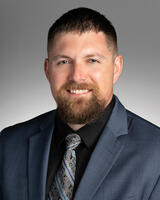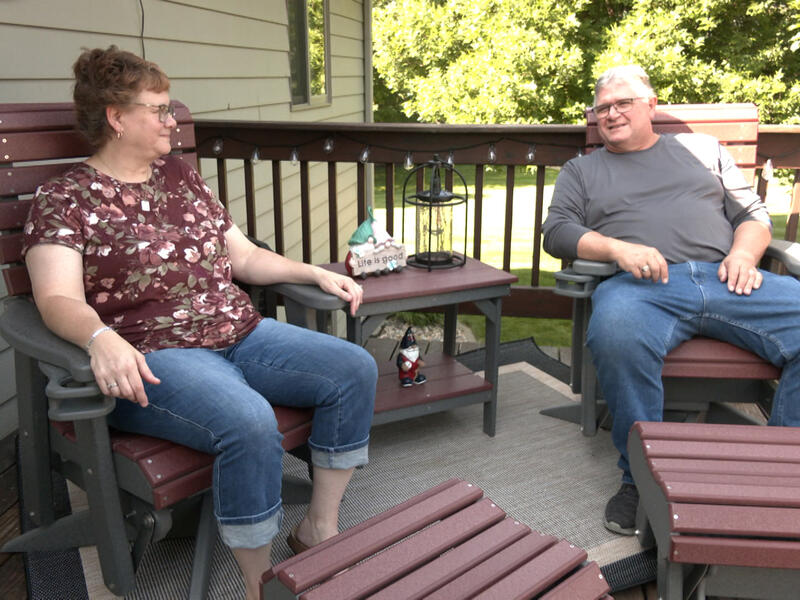Tammy Rieger thought she had simply pulled a muscle.
She and her husband Don live just on the outskirts of Milbank, South Dakota. You’re driving in town, but if you peel off on their street, it suddenly becomes the country.
Don, a self-described “farm kid,” wanted the best of both worlds. Living in town but still having some privacy. They call their home their little safe haven.
Upon driving up their driveway, you’ll see many, many flower beds and other plants. Tammy takes pride in caring for them, and that’s where our story starts.
She was working one day when she felt like she “had pulled a groin muscle.” She treated it as such, resting and alternating heat and ice. The pain didn’t get better, and eventually she made an appointment with her general practitioner. She started on physical therapy.
A lump, and a rare diagnosis
A month went by, and the pain never left.
“I kept rubbing and I felt something. I said to my husband, ‘Can you rub my leg? But you really have to push. It feels like it’s something deep.’”
Her husband Don felt a large bump and urged her to go back to get it checked out.
She had an MRI done and was referred for a biopsy.
“They then put me into Dr. Johnson’s care. They had figured it was something soft tissue,” recalled Tammy.
“They told me I had extraskeletal myxoid chondrosarcoma.”
Extraskeletal myxoid chondrosarcoma is a rare type of muscular cancer. Joshua Johnson, M.D., is an orthopedic surgeon and orthopedic oncologist at Sanford Health in Sioux Falls, South Dakota. He explained the meaning of sarcoma, originating in Greece:
- sarcs = flesh
- oma = tumor
“So, tumor of the flesh, meaning connective tissue,” Dr. Johnson said. “It can be from muscle, tendon, body fat, or any of those tissues. Tammy’s was a type of extraskeletal chondrosarcoma, meaning a chondrosarcoma that arises in the soft tissues, or muscles, instead of the bone or cartilage.”

The bigger the sarcoma, the higher the risk for growth and spread.
“It was probably the size of an orange,” he added.
Laying out treatment
Treatment for a soft tissue sarcoma consists of a combination of radiation and surgery.
“Surgery is to remove it. Radiation is to improve local control – meaning decreasing the chances of it coming back in the same spot,” said Dr. Johnson.
He said radiation can be done either before or after surgery, and it doesn’t have a difference in patient outcomes.
“What is different is the amount of radiation they have to use. They use a smaller dose over a smaller field if they radiate before the surgery.
“If it’s after, they sort of have to guess where the tumor was and where we were during the surgery, so they use a larger dose over a larger field,” he explained.
He said the downside to radiating before surgery is higher rates of wound healing problems. Because of this, treatment had to be broken up into smaller doses.
“It’s usually five days a week for about a month that they radiate it. Then we let their skin rest for a couple weeks; then we do surgery to remove the tumor. They heal up from that, and then we move into what’s called surveillance, which is what she’s doing right now. We’re watching to see if a tumor is coming back,” said Dr. Johnson.
Being patient
The highest risk of cancer recurrence for sarcomas are in the first two years.
Tammy’s surveillance consists of an MRI of the outer left leg, which is where the sarcoma was, and a CT scan of her chest every three to four months. She does a CT scan, “because the most common place for a sarcoma to spread is to the lungs,” according to Dr. Johnson.
Tammy is just under three years out from surgery. On scans she has no evidence of disease, but she still needs to be patient.
At year three of treatment, the MRIs and CTs are reduced to every four to five months. At years four and five, it’s every six months, and then once a year until year 10.
“Most people follow a sarcoma for about 10 years. After that, the likelihood of it coming back is so exceedingly low that we basically say you’re cancer free,” said Dr. Johnson.
Dr. Johnson said it’s unique that Sanford Health offers musculoskeletal oncology.
“It’s a small field. There’s not a lot of us out there across the U.S.,” he said – only 100-200 physicians in the specialty, according to the American Medical Association and OrthoIndy.
“To have this offered in a community the size of Sioux Falls is unusual, but we are the only Level I in the state. Pretty much everything gets routed through Sioux Falls before going elsewhere. It’s worked to have it here.”
Rely on care team
Today, Tammy is back to tending to her flowers and plants. She and Don bought a camper and are counting down the days until retirement.
She said it’s important to have a relationship with a primary care provider.
“Don’t just assume it’s nothing. I could have just assumed and said it’s a pulled muscle that’s just not getting better and not went and checked it out. I had that cramp and I knew it was something more.
“You have to listen to what your body is telling you and you go to those care providers that have that knowledge and know where to get you, which for me was Dr. Johnson. I was so fortunate to have an orthopedic oncologist here.”
Learn more
- 2-year-old cancer patient back home after nearly 200 days
- Breast cancer survivor returns to work with cancer patients
- Nurse navigator guides lymphoma patient’s journey
…
Posted In Cancer, Orthopedics, Sioux Falls

